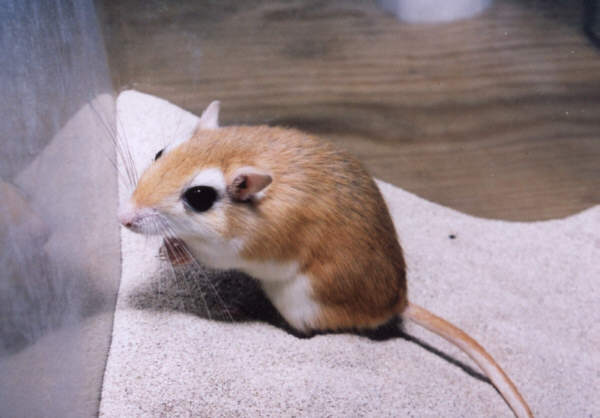
Cheesman's Gerbil
By Julian Barker
First appeared in the June 2001 isue of the NGS Journal
Cheesman's Gerbil (Gerbillus cheesmani) has started to
appear in the UK as a pet. It is a typical Gerbillus species, very like the Pallid
Gerbil (G. perpallidus) that has been available as a pet in the UK
for at least ten years, in colour, behaviour and general appearance.
The most obvious difference is the length of the almost naked
tail. Pallid gerbils have a tail a little longer than the head and body,
Cheesman's gerbils have a tail significantly longer, maybe 30% longer than the
head and body length. Cheesemans Gerbil is also a little smaller than a Pallid
Gerbil, although not as small as a Lesser Egyptian Gerbil
(G. gerbillus)
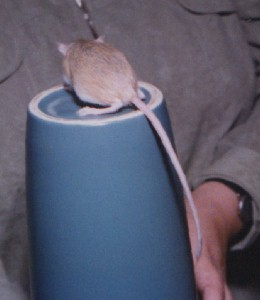
In temperament Cheesman's gerbils are very placid, being both
inquisitive and apparently totally unafraid of humans. They are easy to handle,
and never seem to bite. They can be cared for much like Mongolian Gerbils
(Meriones unguiculatus), and like their Pallid cousins they do enjoy insect
food, but that is not essential.
Cheesman's Gerbils come from the whole of the Arabian Peninsular
and the sandy areas of Southern Iraq, Southern Iran, Pakistan and extending into
South Western Afghanistan. They live in shifting sand dunes and dried out
mudflats. It has been described as very well camouflaged for sandy habitats. If
the gerbil freezes, it effectively disappears from sight!
They are not very social. They tend to nest separately in the
wild, but in captivity live happily in small groups. Their burrows tend to be
clustered in groups of two or three, but each burrow is separate with few
chambers. The nesting chamber, where the gerbil takes refuge from the heat of
the day, and the cold of night can be up to 1.25 metres (four feet) deep.
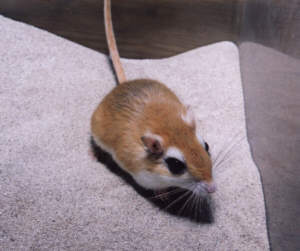
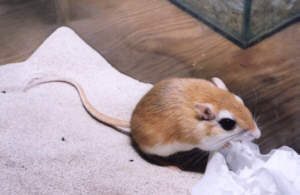
They are quite agile, and have been observed climbing to the top
of 600mm (two foot) high shrubs to feed on the seed heads. Seeds and plant
material constitute most of their diet. It is not known if they eat insects In
the wild, but, based on their behaviour in captivity, they probably do.
Studies in their native habitat suggest that Cheesman's Gerbils
breed in winter. They can survive in areas with quite cold winters and often
occupy desert areas well above 1000 metres (3000 feet) in height.
In general they are nocturnal in habit, although they do forage
in the late afternoon. In captivity they wake and eagerly explore any
interruption like Mongolian Gerbils do.
Unlike many other gerbils Cheesmans are not an economic pest
because they live in areas to hostile for agriculture. Despite their remote
habitat, they are known to have many predators including Sand Cats (Felis
margareta), Foxes (Vulpes vulpes), Owls (Athene noctua and
Otus brucei) and Snakes (Eristochophis mcmahonii and Sphalerosophis
arenarius).
MAMMALS OF SAUDI ARABIA - ON A COLLECTION OF RODENTIA FROM
SAUDI ARABIA: BŁttiker and Harrison D L., 1982, FAUNA OF SAUDI ARABIA, 4,
488-502
THE MAMMALS OF ARABIA (Second Edition), Harrison DL, Bates PJJ, Harrison
Zoological Museum Publication, 1991, 268-305
A SURVEY OF THE MAMMALS OF AFGHANISTAN, Hassinger, Jerry, D., Fieldiana, 1973
ARABIAN MAMMALS - A NATURAL HISTORY: Kingdom Jonathan, 1990, 52-57
THE MAMMALS OF PAKISTAN (REVISED EDITION), Roberts, T.J., Oxford University
Press, 1997, 278-300
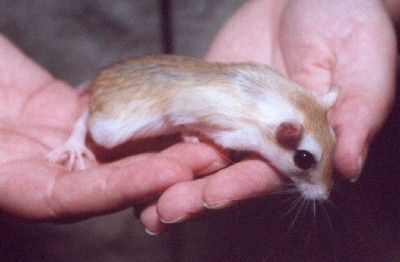

The NGS also has a complete list of gerbil species
including distribution.
































Return to the NGS Homepage?
The views presented on this page are not necessarily those of the National
Gerbil Society.
Please note that the material on these webpages is covered by copyright law.
If you wish to use any pictures etc for anything other than your personal
private use, such as publishing material on a website, then
This web page may include links to other web sites. These links are provided
in order to enhance the interest and usefulness of other content and are not
intended to signify that the National Gerbil Society, or the authors of material
featured on the NGS Website, endorses or otherwise has any responsibility for
the content of any linked web page, web site or other linked material.
This page has been constructed by
Telephone number for media contact only - (+44)
07941893143
Last updated 31 August 2005





